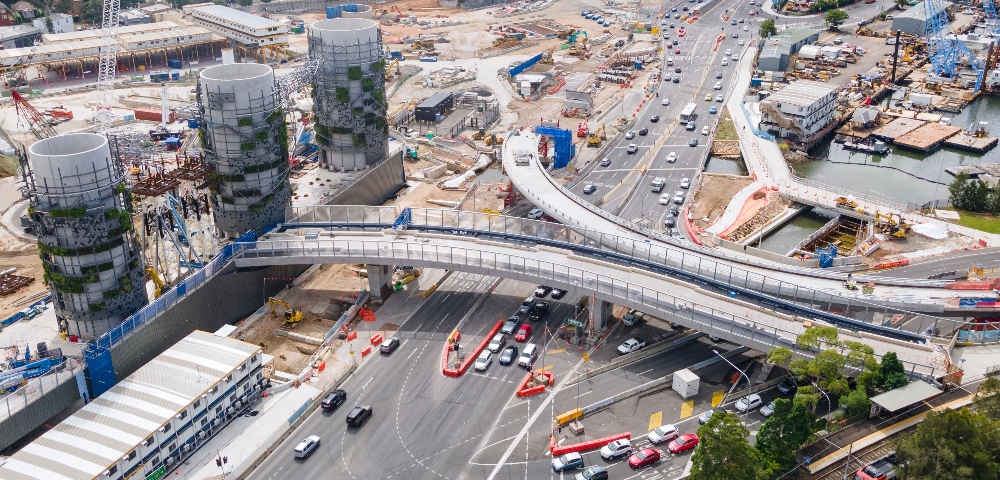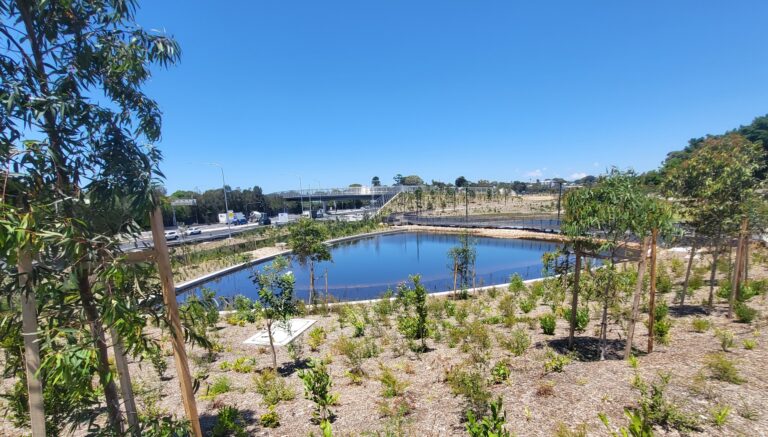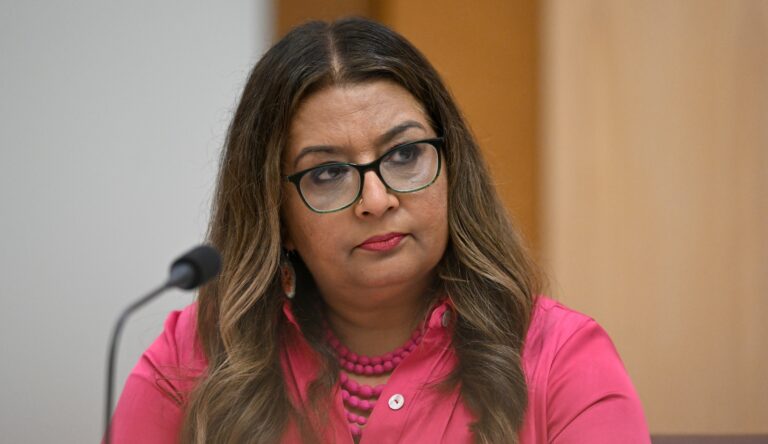
Sydney’s exhaust pipe

by PETER HEHIR
Both Transport for NSW (TfNSW) and John Holland CPB Contractors, the builders of the Rozelle Interchange, are currently engaged in a duplicitous media campaign in an attempt to quieten the legitimate health concerns expressed by the residents of Balmain, Birchgrove, Rozelle, Lilyfield, White Bay, Leichhardt, and Annandale in relation to the unfiltered exhaust stacks in the Rozelle Parklands.
‘Breathe easy – the ventilation system for the Rozelle Interchange project has been designed in line with the world’s best practices to meet strict guidelines on air quality’.
So says the puff piece jointly published by both the NSW Government through TfNSW and the builders of the Interchange. ‘Breathe easy’ is a monstrous lie. Failure to filter the exhaust stacks is the very antithesis of ‘world’s best practices’.
When the plans for WestConnex went on public display in 2016, a great many thousands of residents expressed serious concerns about the unfiltered exhaust stacks and the impact of the carcinogenic emissions from the four stacks planned in Rozelle. Following the public outcry the apolitical RAW (Rozelle Against WestConnex) was formed.
These stacks have always been euphemistically referred to as ‘ventilation facilities’. This was a cynical attempt to disguise their true purpose. The statement: ‘designed in line with the world’s best practices’, is grossly mendacious. In the 21st century the world’s best practice has always been to filter road tunnel exhaust gases, removing both particulate matter and the oxides of nitrogen.
In 2012 the World Health Organisation (WHO) identified diesel exhaust as a carcinogen responsible for at least eight forms of cancer.
The precursor to TfNSW was the Roads and Maritime Service. The unfiltered M5 East tunnel was designed by them in the late 20th century and opened in 2001. A number of delegates from the RMS visited the Yamate Road tunnel in Tokyo, which opened in 2007. This 18 kilometre long tunnel was then one of the longest road tunnels in the world.
It employed cutting edge in tunnel filtration and was extremely successful in removing the carcinogenic diesel particulate matter and also the harmful oxides of nitrogen. The removal rate was almost 100%. So much so that the scrubbed air in the tunnel was measurably much cleaner than the Tokyo air above.
Following the visit to the Yamate, the NSW government and John Holland (the builder of the Yamate Tunnel) were both well aware of precisely what constituted ‘world’s best practice’. John Holland not only built the filtered Yamate Tunnel, but they also constructed the unfiltered Rozelle Interchange, which opened to such chaos some days ago. The Rozelle Interchange was under the direct management of TfNSW. Clearly neither the builder nor TfNSW could plead ignorance of the world’s best practice in relation to filtration.
This is an absolutely essential component of modern road tunnels, especially so in the Rozelle Interchange, currently the largest and most complex road tunnel network anywhere in the world. An almost 100% effective result, comparable to the successful filtration in the Yamate, was also realised with the Calle 30 in Madrid; and indeed in many other countries, including the recent Central Kowloon Route in Hong Kong.
World’s best practice is to filter both particulate matter and nitrogen dioxide. It is absolutely essential in order to protect the health of residents living in the fallout zones and that of the tunnel users. This is recognised internationally. It is an indisputable fact. Failure to filter is a monumental and indefensible dereliction of duty and a gross miscarriage of justice.
The TfNSW press release continues: ‘Each outlet is strategically located to facilitate the proper dispersion of tunnel emissions and maintain air quality standards’.
This statement is risible. The strategic location is clearly more political than geographic. It appears that the siting of these ‘strategically located’ exhaust stacks has much more to do with the fact that both of the major parties had lost the support of the Inner West community at the State level. Obviously neither had any reason to fear an electoral backlash. The siting was more punitive than pragmatic.
Placing three huge stacks emitting cancer causing fine diesel particulates, < 2.5 PM – conservatively estimated at well in excess of 200 tonnes annually – in a 10 hectare public parkland; and in a valley at sea level, with regular overnight temperature inversions for most of the year, is a reasonable definition of insanity.
The inversions ensure that the emissions stay below the mixing level and therefore they spread out laterally. The plumes are unable to penetrate the inversion layer. There are many examples of this phenomena on the internet, including the behaviour of the visible particles from the fire in the Burnley Road Tunnel in Melbourne.
This 200 tonne estimate of emissions has been extrapolated by a retired scientist initially from Residents Against Polluting Stacks (RAPS) and subsequently a member of RAW, using figures supplied daily from the RMS (now TfNSW), over the past twenty two years, in relation to one of Sydney’s early road tunnels, the 3.9 klms M5 East.
A conservative annual emission figure is one metric tonne for each lane kilometre of tunnel.
The predicted peak hour outpourings of lethal emissions are now painfully evident to all of the residents who live in the proximity of the two recently operational stacks in the Rozelle Parklands.
Burning eyes, coupled with the overpowering stench of vehicle exhaust is unmistakeable, causing people to retch and gag. It is particularly noticeable in the early morning and the evening peak periods. Asthmatics and those with respiratory conditions are suffering. In my 50 years in the same Rozelle location nothing even remotely approaching this has ever been experienced before.
The third operational exhaust stack on Victoria Road emits significantly less material – a similar quantity, based on tunnel length and traffic volumes to the now twenty two year old M5 East stack at Turrella. These emissions are a serious and legitimate concern of the residents living in the adjacent Balmain Shores; and those in Drummoyne, Balmain, Lilyfield, and North and South West Rozelle, when they find themselves downwind of the plume.
The M5 East stack at Turrella was cited as the likely cause of the 44% increase in lung cancers detected earlier this century in those who lived in the path of the plume.
When it was discovered, this aberrant cancer cluster caused alarm bells to ring. So much so that an investigation was immediately undertaken by the then South Sydney Area Health Service. During the period when the 44% increase was monitored and recorded, the statewide incidence of lung cancers had fallen by 9%. No conclusion was ever reached as to causality and the promised follow up investigation was never conducted.
TfNSW asks us to; ‘Please visit Transport for NSW’s air quality portal for information regarding NSW air quality in general, road tunnels, vehicle emissions, regulating air quality, tunnelling, filtration systems, frequently asked questions and how Sydney compares to the rest of the world’.
There is no freely available data on the composition of the exhaust material on their portal. Surprisingly, none of the equipment used to measure air quality anywhere in NSW can differentiate between a benign particle of dust and the carcinogenic, fine diesel exhaust particles.
According to the TfNSW air quality portal, the Rozelle Interchange doesn’t even exist! Nor does particulate filtration in the Calle 30. Neither the filtered Yamate Tunnel in Tokyo nor the Central Kowloon Route in Hong Kong, are even mentioned.
The tens of thousands of residents impacted by the four Rozelle stacks have always believed that importing all of the unfiltered, city bound, vehicle exhaust from the suburbs feeding into the M8 and the M4-M5 Link, as well as those from Homebush, Newtown, Ashfield – and even from Cammeray when the Western Harbour Tunnel comes on line; was a massive failure of the NSW and Federal Governments to meet their duty of care.
Deliberately ignoring the science and the proven filtration technology by releasing the unfiltered, cancer causing material via the three massive stacks in the Rozelle Parklands, and the fourth on Victoria Road, is nothing short of deliberate, government sanctioned democide.
TfNSW lying so brazenly and telling us to ‘Breathe easy’, is cynical proof of their unconscionable mendacity.
The Rozelle Parklands’ grand opening to the public was on Sunday the 17th of December at 11 am.
The only plausible explanation for this late opening time, in the heat of the day, was to permit the overnight build-up of the toxic emissions to finally dissipate as the mixing level rises. This is presumably to ensure that those attending were deliberately misled about the emissions.
If you do plan on using the park during periods of extended temperature inversions I’d strongly recommend that you wear a good quality particulate filter.
This article was first sent to members of Rozelle Against WestConnex (RAW) a few days before the Parklands opened on December 17 last year.









